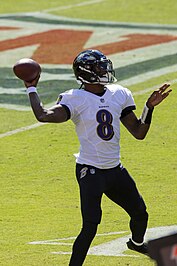In gridiron football, a dual-threat quarterback, also known as a running quarterback,[1] is a quarterback (QB) who is able to run with the ball as effectively as they can pass. With the rise of several blitz-heavy defensive schemes and increasingly faster defensive players, the importance of a mobile quarterback has been redefined. While arm power, accuracy, and pocket presence – the ability to successfully operate from within the "pocket" formed by his blockers – are still the most important quarterback virtues, the ability to elude or run past defenders creates an additional threat that allows greater flexibility in the team's passing and running game.
College football teams employed option offenses earlier and more commonly than offenses in the National Football League (NFL). An option offense allows the quarterback to either hand the ball off, run it himself, or pitch it to the running back (RB). In the college game, many schools employ several plays that are designed for the quarterback to run with the ball. Reggie Collier was an early example of a dual-threat in college, with Brian Mitchell and Charlie Ward being other examples of 20th-century dual-threats. In the 21st-century, Tim Tebow emerged as both an effective runner and passer with the football, being widely regarded as one of the best dual-threats in college football history. Cam Newton and Lamar Jackson also notably enjoyed success in college.
For much of the NFL's modern existence, quarterbacks running with the football was less common and often came in the form of the quarterback sneak. However, there was still some of an emphasis on being mobile enough to escape a heavy pass rush. Historically, dual-threat quarterbacks in the NFL were uncommon through the AFL–NFL merger, although Tobin Rote and Fran Tarkenton proved to be successful scrambling quarterbacks. Players like Randall Cunningham, John Elway, and Steve Young had success running in the 1980s and 1990s. Steve McNair and Donovan McNabb followed in the late 1990s into the mid-2000s. Michael Vick is often credited as having ushered dual-threat quarterbacking into the sport's mainstream in the 2000s.[2] In the 2010s, quarterbacks with dual-threat capabilities became increasingly more common. Cam Newton and Lamar Jackson, two quarterbacks who found NFL success in the 2010s and the 2020s, have cited Vick's influence on their playing styles.[3][4][5] The Canadian Football League (CFL) has also seen dual-threat quarterbacks throughout its history. CFL quarterbacks such as Russ Jackson and Damon Allen ran the ball commonly during the 20th-century, and offenses have continued to utilize dual-threats in more recent history.
The term dual-threat has received scrutiny by some black quarterbacks, with it being viewed as part of the broader racial issues black quarterbacks encounter in the sport. Those critical of the term assert that black quarterbacks are not viewed as "pro-style" quarterbacks and instead stereotyped as dual-threats, and therefore thought of as run-first players or not smart enough when making passing decisions.
- ^ Benoit, Andy (June 5, 2014). "NFL's Best Running Quarterback? The Answer May Surprise You". Sports Illustrated. Archived from the original on October 24, 2014. Retrieved December 8, 2014.
- ^ Johnson, Dalton (April 30, 2020). "Jimmy Garoppolo reveals Mike Vick was his favorite player growing up". NBC Sports. Archived from the original on June 6, 2020. Retrieved February 19, 2021.
He [Michael Vick] spear-headed making the dual-threat QB mainstream, especially in pop culture with video games like Madden.
- ^ Hartwell, Darren (September 27, 2020). "Newton hits historic mark on first Week 3 rush for Pats". NBC Sports. Archived from the original on January 16, 2021. Retrieved February 19, 2021.
- ^ Wesseling, Chris (July 6, 2016). "Is Cam Newton the greatest dual-threat QB in history?". NFL.com. Archived from the original on October 12, 2020. Retrieved February 11, 2017.
- ^ Mink, Ryan (May 2, 2018). "Lamar Jackson Modeled His Game After Michael Vick, Starting With 'Madden'". baltimoreravens.com. Archived from the original on July 18, 2024. Retrieved February 19, 2021.

